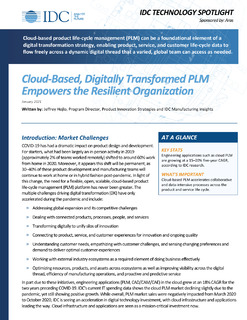COVID-19 has had a dramatic impact on product design and development. For starters, what had been largely an in-person activity in 2019 (approximately 2% of teams worked remotely) shifted to around 60% work from home in 2020. Moreover, it appears this shift will be permanent, as 30–40% of these product development and manufacturing teams will continue to work at home or in hybrid fashion post-pandemic. In light of this change, the need for a flexible, open, scalable, cloud-based product life-cycle management (PLM) platform has never been greater. The multiple challenges driving digital transformation (DX) have only accelerated during the pandemic and include:
- Addressing global expansion and its competitive challenges
- Dealing with connected products, processes, people, and services
- Transforming digitally to unify silos of innovation
- Connecting to product, service, and customer experiences for innovation and ongoing quality
- Understanding customer needs, empathizing with customer challenges, and sensing changing preferences and demand to deliver optimal customer experiences
- Working with external industry ecosystems as a required element of doing business effectively
- Optimizing resources, products, and assets across ecosystems as well as improving visibility across the digital thread, efficiency of manufacturing operations, and proactive and predictive service
In part due to these initiatives, engineering applications (PLM, CAD/CAM/CAE) in the cloud grew at an 18% CAGR for the two years preceding COVID-19. IDC's current IT spending data shows the cloud PLM market declining slightly due to the pandemic, yet still showing positive growth. While overall, PLM market sales were negatively impacted from March 2020 to October 2020, IDC is seeing an acceleration in digital technology investment, with cloud infrastructure and applications leading the way. Cloud infrastructure and applications are seen as a mission-critical investment now.

